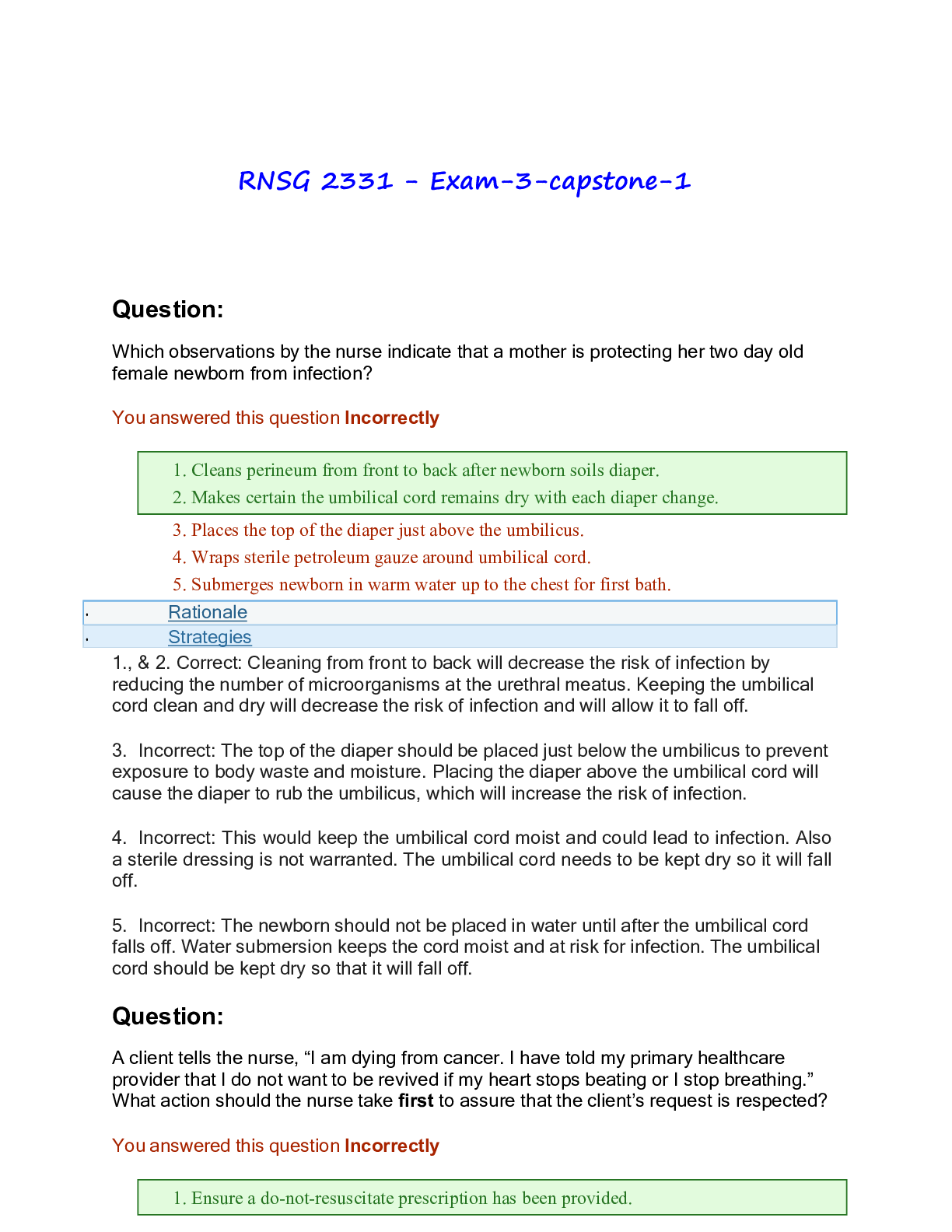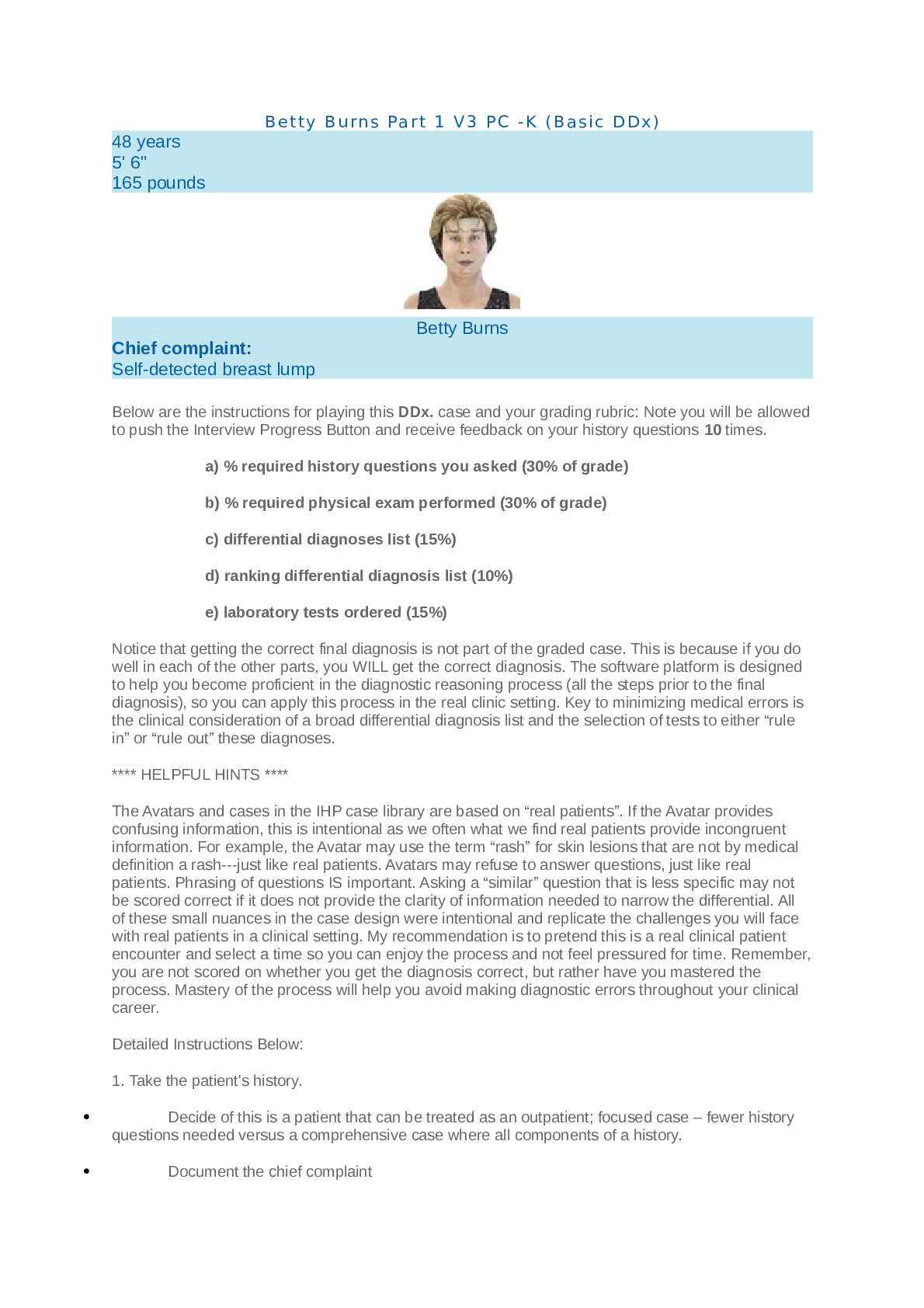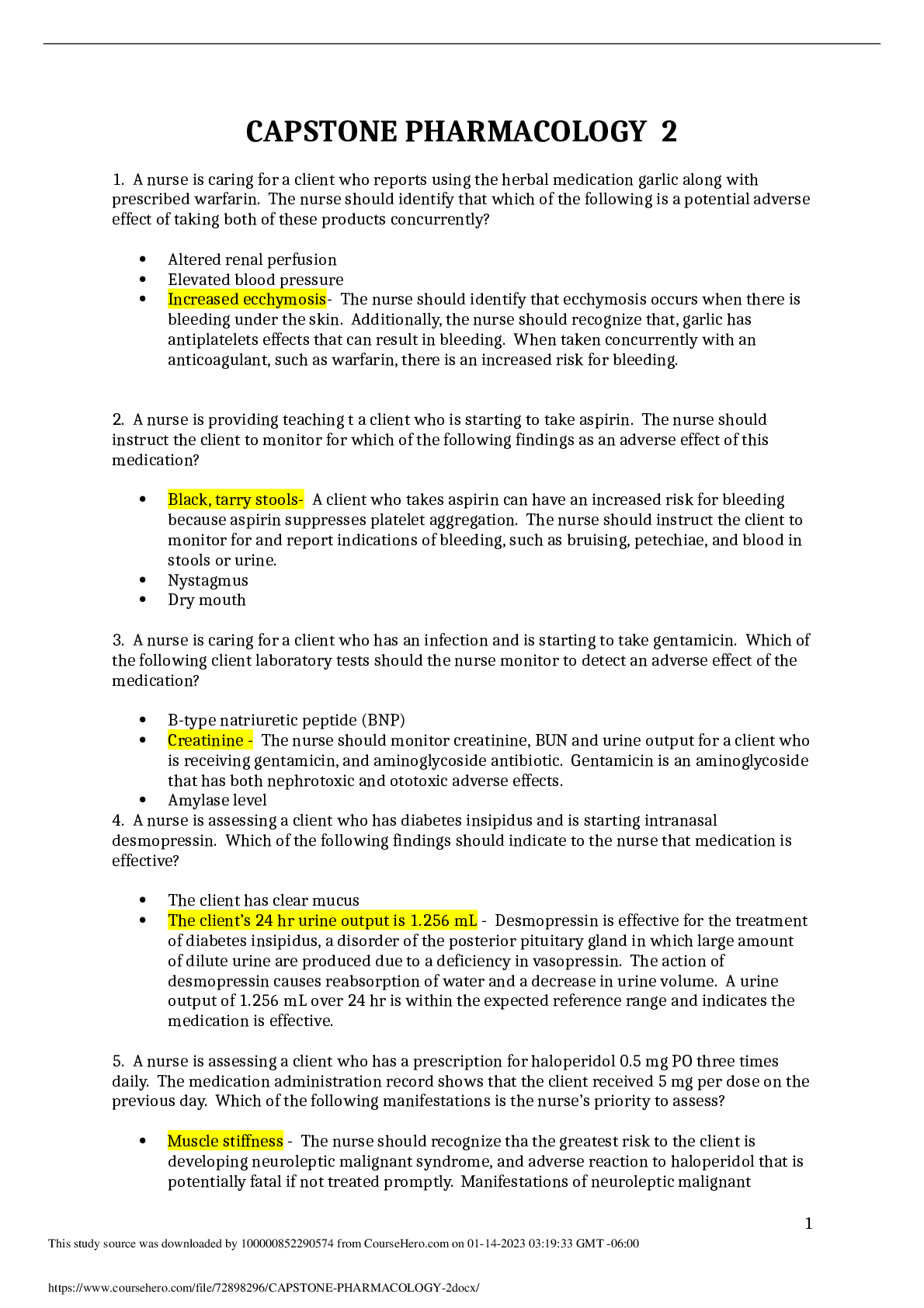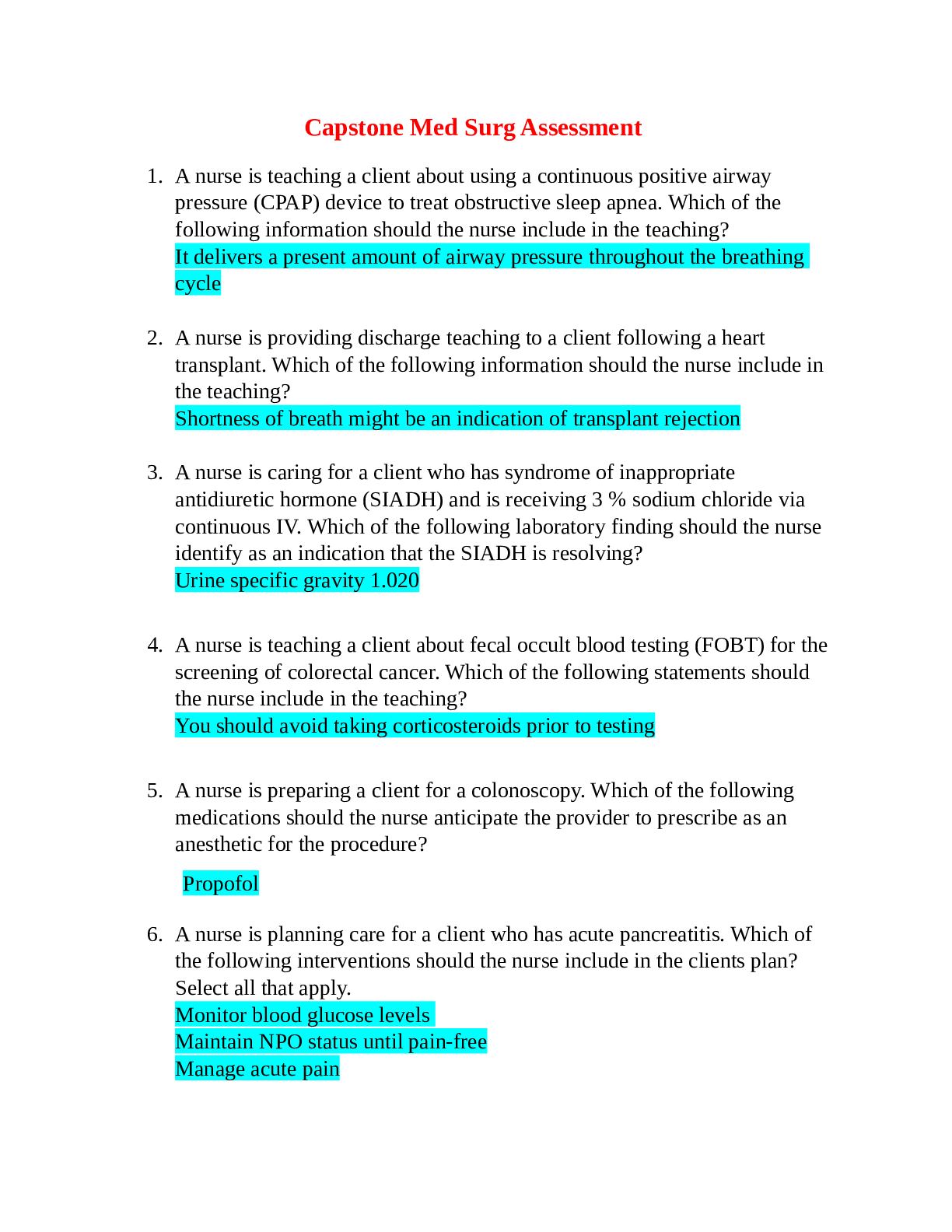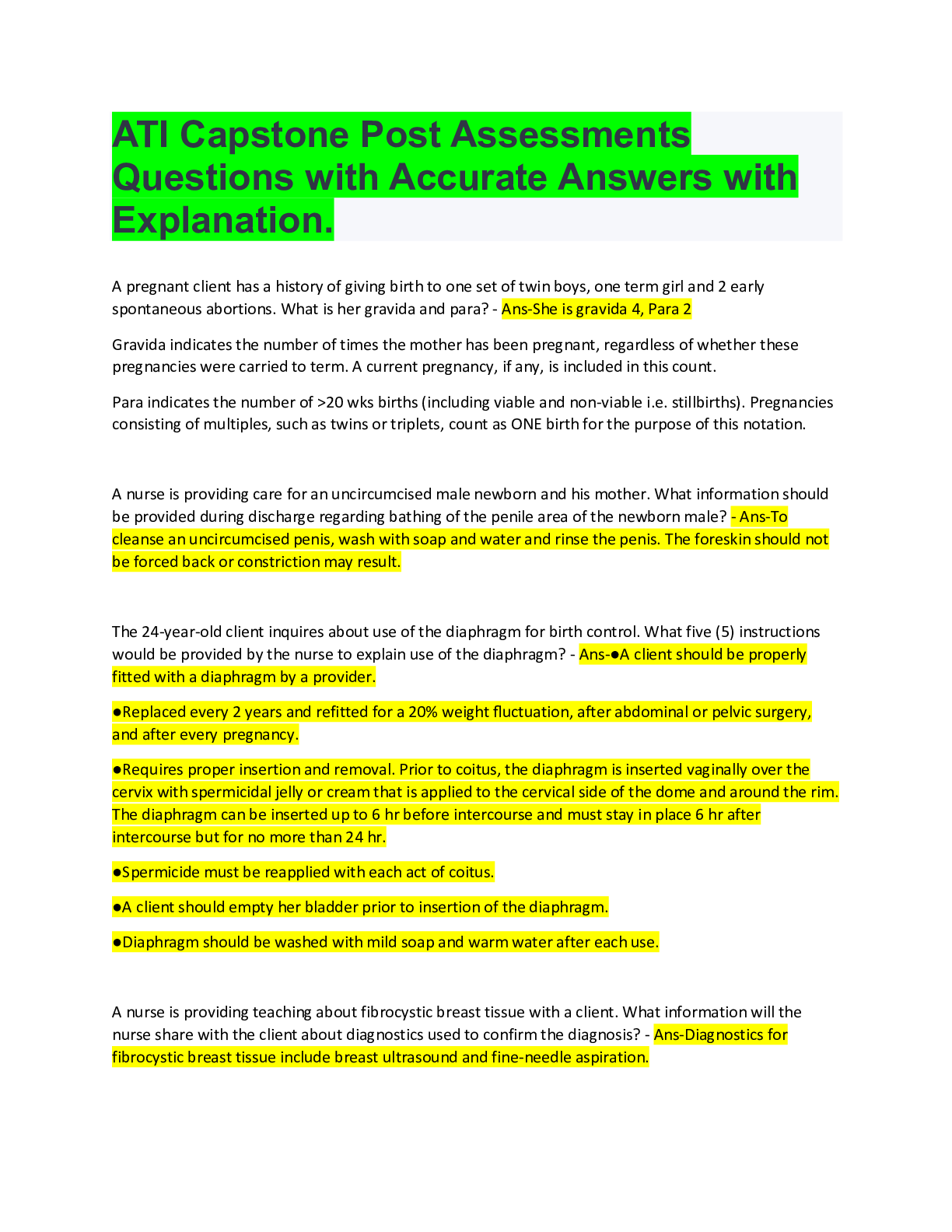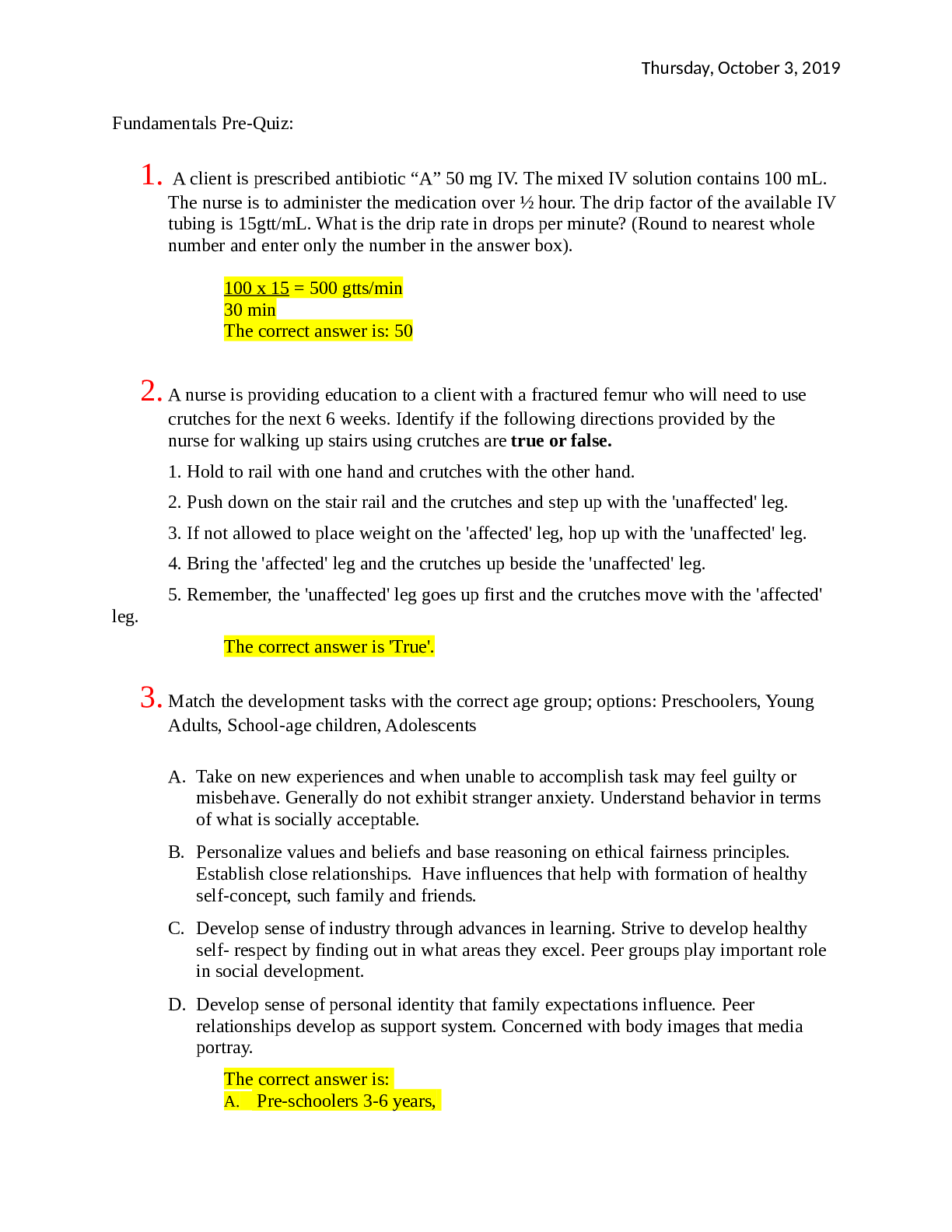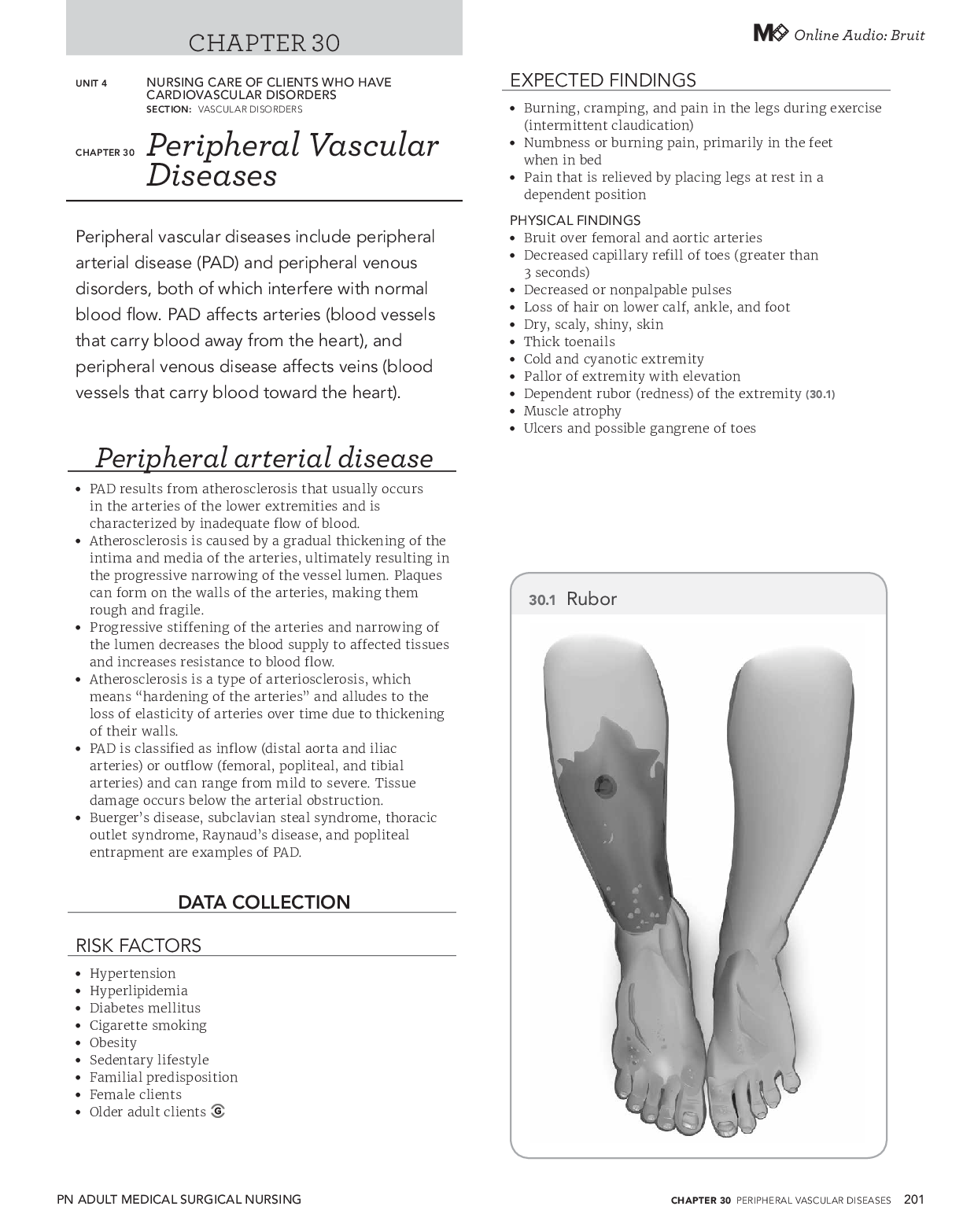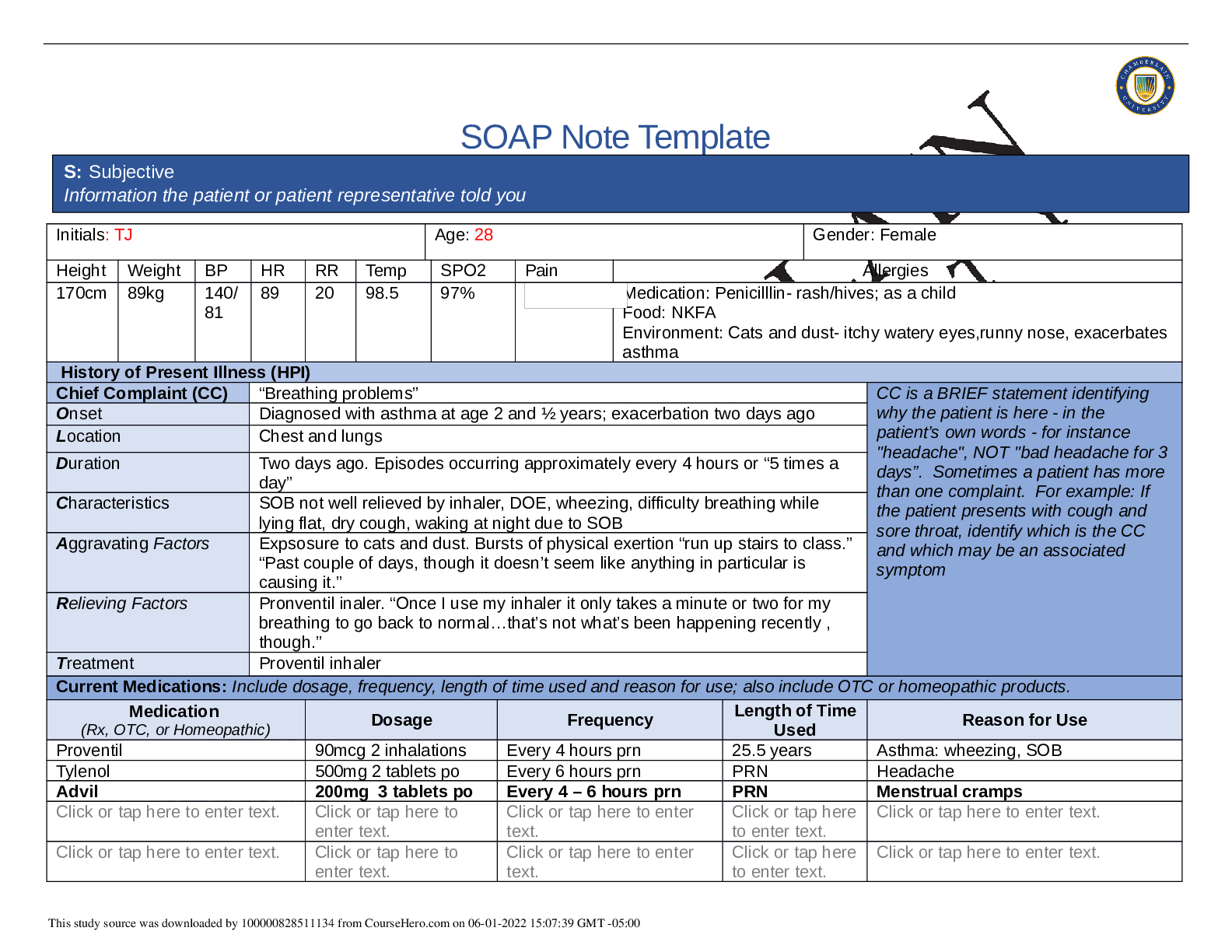*NURSING > CAPSTONE SIMULATION > NURS 406 Capstone Quiz Assessment Mental health /NURS406Capstone Quiz Assessment Mental health/Exam (All)
NURS 406 Capstone Quiz Assessment Mental health /NURS406Capstone Quiz Assessment Mental health/Exam (elaborations) NURS 406Capstone Quiz Assessment Mental health (NURS 406Capstone Quiz Assessment Mental health)
Document Content and Description Below
NURS 406 Capstone Quiz Assessment Mental health /NURS406Capstone Quiz Assessment Mental health/Exam (elaborations) NURS 406Capstone Quiz Assessment Mental health (NURS 406Capstone Quiz Assessment Ment... al health) Capstone Mental health assessment victoria final 1. A nurse is discussing discipline techniques with the parent of a preschooler. Which of the following statements by the parent indicates an understanding of time-out as a form of discipline? "I place my child in time-out for 15 minutes when they misbehave." "I send my child to their room for the time-out period." "I make use of time-out after giving three warnings." "I use a kitchen timer to mark the end of the time-out period." 2. A nurse in a well-child clinic receives a phone call from the parent of an adolescent client. The parent states, "I think my son might try to kill himself." Which of the following statements by the parent is the priority for the nurse to investigate further? "I can hear him crying in the middle of the night." "He spends most of his time locked in his room." "He refuses to go to the movies with his friends." "I noticed several cutting marks on both of his arms." 3. A nurse is caring for an adult client who is receiving treatment for alcohol use disorder. The client is upset because his partner has refused to visit him in the treatment facility. Which of the following actions by the client should indicate to the nurse that the client is using regression as a defense mechanism? The client states that he has developed sudden hearing loss. The client states that his partner will not visit because they are too busy with their job. The client yells obscenities at the nurse. The client stomps his feet and throws objects o his bedside table 4. A nurse is admitting a client who has posttraumatic stress disorder (PTSD) to a community mental health facility. Which of the following manifestations should the nurse expect when completing the admission assessment? Decreased startle response to loud noises Reports uninterrupted sleep of 10 to 12 hr each night Reluctance to discuss the event that precipitated the distress Reports feelings of acute distress that began 1 to 2 weeks ago 5. A nurse is conducting a child maltreatment screening of a family who has a toddler. Which of the following findings should the nurse identify as an indicator of possible child neglect? The child has a history of jaw factures. The child seems frightened of their parent. The child has had no immunizations since birth. The child rocks back and forth continually. 6. A nurse in an urgent-care clinic is caring for a school-age child who has several visible bruises. The child's parent states, "My partner got red today and came home angry. I don't think this will happen again." Which of the following responses should the nurse make? "I agree with you. I'm sure this will never happen again." "This is awful. You should le charges against your partner." "This is clearly child endangerment. I will have to call the police." "I'd like to know more about what happened. Let's sit and talk." 7. A nurse is caring for a client who has dementia and insists a doll is her infant child. Which of the following behavioral management techniques should the nurse use when interacting with the client? Cognitive reframing Thought stopping Validation therapy Operant conditioning 8. A nurse is planning care for a client who has major depressive disorder and is being admitted following a suicide attempt. Which of the following interventions is the nurse's priority? Initiate one-to-one observation. Encourage the client to participate in group activities. Administer an antidepressant. Set up a time for individual meetings with the client. 9. A nurse is caring for a client who is aggressive toward other clients and has been placed in wrist restraints. After obtaining a prescription for restraints from the provider, which of the following actions should the nurse take? Document the client's behavior once every hour. Keep the client in restraints until the prescription expires. Conduct a debrieng regarding the client with the unit staff. Request an evaluation of the client within 12 hr of application of restraints. 10. A nurse is providing teaching to a client who has a prescription for disulram. Which of the following client statements indicates an understanding of the teaching? "If I drink alcohol, I will become very sick." "If I drink alcohol, I will not be able to fall asleep." "If I drink alcohol, I will lose control of my inhibitions and say something I don't mean." "If I drink alcohol, I will have severe mood swings and exhibit belligerent behavior." 11. A nurse is reviewing the medical record of a newly admitted client who has major depressive disorder. Which of the following findings should the nurse identify as a risk factor for this condition? The client has a serotonin deficiency. The client has acute bronchitis. The client has an elevated calcium level. The client is an only child 12. A nurse on a medical-surgical unit is caring for a client who tells the nurse about their intentions to harm an ex-partner. Which of the following actions is a legal duty of the nurse? Keep the client hospitalized until there is no longer a threat. Ensure the client's ex-partner is notified of the threat. Ask a friend or family member to monitor the client. Transfer the client to a mental health facility. 13. A nurse is providing teaching to the caretakers of a client who has Alzheimer's disease with mild cognitive decline. The client is beginning to experience sleep disturbances. Which of the following instructions should the nurse include? Give the client a cup of hot black tea before bed. Wake the client at the same time each morning. Take the client for a walk 2 hr before bedtime each night. Allow the client to take a 90-min nap immediately after lunch. 14. A nurse on a mental health unit is planning a group therapy session about assertiveness training. For which of the following clients should the nurse recommend the training? A client who has new-onset delirium A client who is experiencing auditory hallucinations A client who is experiencing mania A client who has somatic symptom disorder 15. A nurse is caring for a client who has bipolar disorder. The client says to the nurse, "Give me your pen to cut the pain out of my chest." The nurse should identify that the client is at risk for which of the following? Illusion Hallucination Attention-seeking behavior Self-mutilation 16. A charge nurse in a community mental health clinic is discussing ethical concepts of client care with a newly licensed nurse. The charge nurse should use which of the following situations as an example of fidelity? Spending equal time with clients regardless of their insurance status. Explaining possible adverse effects to clients receiving new prescriptions. Respecting the decision of clients to refuse to participate in group therapy. Attending an educational conference on identifying clients at risk for suicide. 17. A nurse is using de-escalation techniques with a client who has become verbally aggressive with a staff member. Which of the following actions should the nurse take? Remain 15 cm (6 in) away from the client Use a raised voice when speaking to the client Determine the cause of the client's feelings Ask the client short, close-ended questions 18. A nurse is discharging a client who was admitted for the treatment of alcohol withdrawal. Which of the following resources should the nurse recommend to the client? Reach to Recovery A 12-step program Al-Anon Light therapy 19. A charge nurse is planning an in-service for newly licensed nurses on tort law in mental health care. Which of the following scenarios should the charge nurse provide as an example of an unintentional tort? A nurse did not clarify a client's prescription that was difficult to read resulting in a medication error. A nurse posted private information on social media about a client who has substance use disorder. A nurse placed a client in mechanical restraints without obtaining a prescription, resulting in injury. A nurse threatened a client with physical harm after the client became verbally abusive to staff members. 20. A nurse is preparing to teach a client who has major depressive disorder and is scheduled to undergo electroconvulsive therapy (ECT). Which of the following statements should the nurse include in the teaching? "ECT is contraindicated in clients who have psychotic symptoms." "ECT is delivered through electrodes attached to the head." "ECT cannot be administered to clients who have suicidal ideation." "ECT is conducted under regional anesthesia." 21. A nurse is caring for a client who exhibits excessive attention-seeking behaviors, including acting irtatious and seductive. The nurse should identify these behaviors as manifestations of which of the following personality disorders? Paranoid Histrionic Narcissistic Antisocial 22. A nurse is caring for a client who is taking a tricyclic antidepressant. For which of the following findings should the nurse monitor as an adverse effect of tricyclic antidepressants? Orthostatic hypotension Diarrhea Hyperactivity Increased urinary output 23. A mental health nurse is providing preventive care for a group of clients in the community. Which of the following actions by the nurse demonstrates a secondary prevention strategy? Leading a group discussion with several clients who have schizophrenia and are dealing with tardive dyskinesia. Screening college students who demonstrate manifestations of depressive disorder. Training volunteers in an adult day care facility to communicate effectively with clients who have cognitive impairments. Teaching personal coping skills to a group of adults whose parents have Alzheimer's disease. 24. A nurse is caring for a client who has posttraumatic stress disorder (PTSD) after being physically assaulted. The client is unable to recall any details of the event. Which of the following defense mechanisms should the nurse recognize that the client is displaying? Dissociation Rationalization Undoing Reaction formation 25. A charge nurse is providing education to a group of newly-licensed nurses about the rights of clients who are involuntarily admitted. Which of the following responses by a newly-licensed nurse indicates understanding of the teaching? "These clients can receive packages after they are privately inspected by security." "These clients cannot be considered for a research study." "These clients can vote in local and federal elections." "These clients cannot refuse their prescribed antipsychotic medications." 26. A home health nurse is caring for a client who reports feeling tired and being unable to grocery shop. Which of the following responses by the nurse is an example of therapeutic communication? "Have you thought about taking a sleeping pill?" "Your fatigue will pass, and everything will be just ne." "Do you have a family member who can assist you?" "Let's discuss how to get you the help you need." 27. A charge nurse on a mental health unit is preparing an in-service for staff members about client rights. Which of the following information should the nurse include? A client who is a voluntary admission does not have the right to request to be discharged. A client who is admitted involuntarily has the right to refuse to participate in therapy. A client who is admitted involuntarily cannot refuse to take prescribed psychotropic medications. A client who is a voluntary admission cannot withdraw consent after it has been given. 28. A nurse is admitting a client who has borderline personality disorder and is at risk for self-mutilation. Which of the following interventions should the nurse incorporate in the plan of care? Provide additional attention to the client. Apply mechanical restraints before administering medication. Obtain a verbal contract from the client. Limit staff members who work with the client 29. A nurse is caring for a client who reports a history of frequent alcohol consumption. Which of the following questions should the nurse ask when screening for alcohol use disorder? "Has a family member indicated that you should cut down on your drinking?" "Have you had a glass of wine in the last week?" "Do you drink alcohol with your friends?" "Do you enjoy drinking alcohol?" 30. A nurse is caring for a client who has just learned that her partner has died by suicide. Which of the following actions should the nurse take first? Refer the client to a support group for survivors of suicide. Offer to contact the client's family or support system. Inform the client that feelings of guilt are often felt by survivors of suicide. Determine the client's understanding of the suicide events. 31. A nurse is caring for a client who has become violent and is threatening self-harm following a crisis. After ensuring enough staff are available, which of the following actions should the nurse take first? Administer a sedative medication. Perform a debrieng with the sta. Acknowledge the client's emotions. Place the client in restraints. 32. A nurse is assessing a client who reports using cocaine 1 hr ago. Which of the following findings should the nurse expect? Polyphagia Fever Bradycardia Oliguria 33. A nurse is assessing an older adult client's ability to make a successful role transition to widowhood following the death of her partner. Which of the following factors should the nurse include in the assessment? (Select all that apply.) The client's advance directives status The client's willingness to attend a support group The client's current health status The client's family support system The client's involvement in a spiritual community 34. A nurse in an acute mental health facility receives change-of-shift report on a group of clients. Which of the following clients should the nurse assess first? A client who has borderline personality disorder and exhibits splitting behaviors A client who has schizophrenia and reports command hallucinations A client who recently started taking lithium and has a new hand tremor A client who takes fluoxetine and states they have a dry mouth 35. A nurse is caring for a client who is receiving haloperidol 2 mg IM every 6 hr. Available is haloperidol 5 mg/mL. How many mL should the nurse administer? (Round the answer to the nearest tenth. Use a leading zero if it applies. Do not use a trailing zero.) Respuesta / 0.4 ML 36. A nurse in an acute care facility is assessing a client who has schizophrenia. The client states, "Walk tall broom short dog bell." The nurse should document the client's speech as which of the following speech patterns? Flight of ideas Word salad Neologisms Clang associations 37. A nurse is caring for a client who has depression and is taking imipramine 300 mg PO divided equally every 6 hr. Available is imipramine 50 mg tablets. How many tablets should the nurse administer per dose? (Round the answer to the nearest tenth. Use a leading zero if it applies. Do not use a trailing zero.) 1.5 tab 38. A nurse is teaching the guardian of a school-age child who has autism spectrum disorder about a new prescription for risperidone. Which of the following statements by the guardian demonstrates an understanding of the teaching? "This medication will help control my child's aggressive behavior." "This medication can cause my child to have low blood sugar." "This medication won't require my child to have routine lab tests." "This medication might need to be increased if my child has muscle spasms." 39. A nurse on a mental health unit is leading a group therapy staff for a group of clients. Which of the following statements should the nurse expect from a client who has illness anxiety disorder? "I check my breasts for lumps every day, but I'm still really scared about getting breast cancer." "I have had several negative pregnancy tests, but I know they are all wrong." "I double-check my pills because I think the pharmacist may be putting poison in them." “I feel really nervous when my partner goes to work and I am home alone during the day.” 40. A nurse is reviewing the medical records of a group of clients. For which of the following clients should the nurse recommend a referral for assertive community treatment (ACT)? A client who has a new diagnosis of major depressive disorder A client who has repeated acute care admissions due to schizophrenia A client who has requested family therapy following the death of a family member A client who has physical injuries following an incident of partner violence 41. A nurse is planning to teach a client who is taking lithium. Which of the following should the nurse include in the teaching as possible adverse effects of therapeutic lithium levels? Weight gain and dry mouth Oliguria and muscle weakness Incoordination and blurred vision Coarse hand tremors and confusion 42. A nurse is assessing a client who has delirium as a result of sepsis. Which of the following manifestations should the nurse expect? (Select all that apply.) Slow speech Rapid mood changes Hallucinations Unaltered level of consciousness Restlessness 43. A nurse is creating a plan of care for a newly admitted client who has obsessive-compulsive disorder. Which of the following interventions should the nurse include? Use detailed explanations when providing education to the client. Maintain a stimulating environment for the client. Provide the client with a structured schedule of daily activities. Limit time for rituals to 30 min each day. 44. A nurse is caring for a client who is experiencing visual hallucinations followed by impaired consciousness as a result of alcohol withdrawal. Which of the following conditions should the nurse identify as causing these manifestations? Autonomic dysreexia Synergistic effect Sleep deprivation Delirium 45. A nurse is caring for a client who has undergone electroconvulsive therapy (ECT). The nurse should monitor the client for which of the following adverse effects of ECT? Voice alteration Neck pain Memory deficit Headache 46. A nurse is conducting an admission assessment for a client who is experiencing a manic episode of bipolar disorder. Which of the following behaviors should the nurse expect? (Select all that apply.) Grandiosity Flight of ideas Splitting Hyperactivity Withdrawa 47. A nurse is caring for a 4-year-old child who has autism spectrum disorder. Which of the following behaviors should the nurse expect? (Select all that apply.) Lack of eye contact Inability to play quietly Constant spinning of a toy Temper tantrums Repeated voiding in clothes 48. A nurse is creating a plan of care for a client who has panic disorder. Which of the following interventions should the nurse include? Encourage the client to attend group therapy sessions. Allow the client to choose scheduled daily activities. Use simple words to describe procedures to the client. Avoid discussing topics that can trigger a panic attack 49. A nurse is planning care for a client who requires close observation. Which of the following rights should the nurse identify that the client has forfeited due to the potential for safety hazards? The right to parity The right to make informed decisions The right to social contact The right to privacy 50. A nurse is reviewing the medical records of a group of clients. For which of the following clients should the nurse implement seizure precautions? A client who is experiencing withdrawal from oxycodone A client who is experiencing withdrawal from diazepam A client who has a low lithium level A client who has a low imipramine level [Show More]
Last updated: 1 year ago
Preview 1 out of 9 pages
Instant download

Instant download
Reviews( 0 )
Document information
Connected school, study & course
About the document
Uploaded On
Mar 10, 2021
Number of pages
9
Written in
Additional information
This document has been written for:
Uploaded
Mar 10, 2021
Downloads
0
Views
2

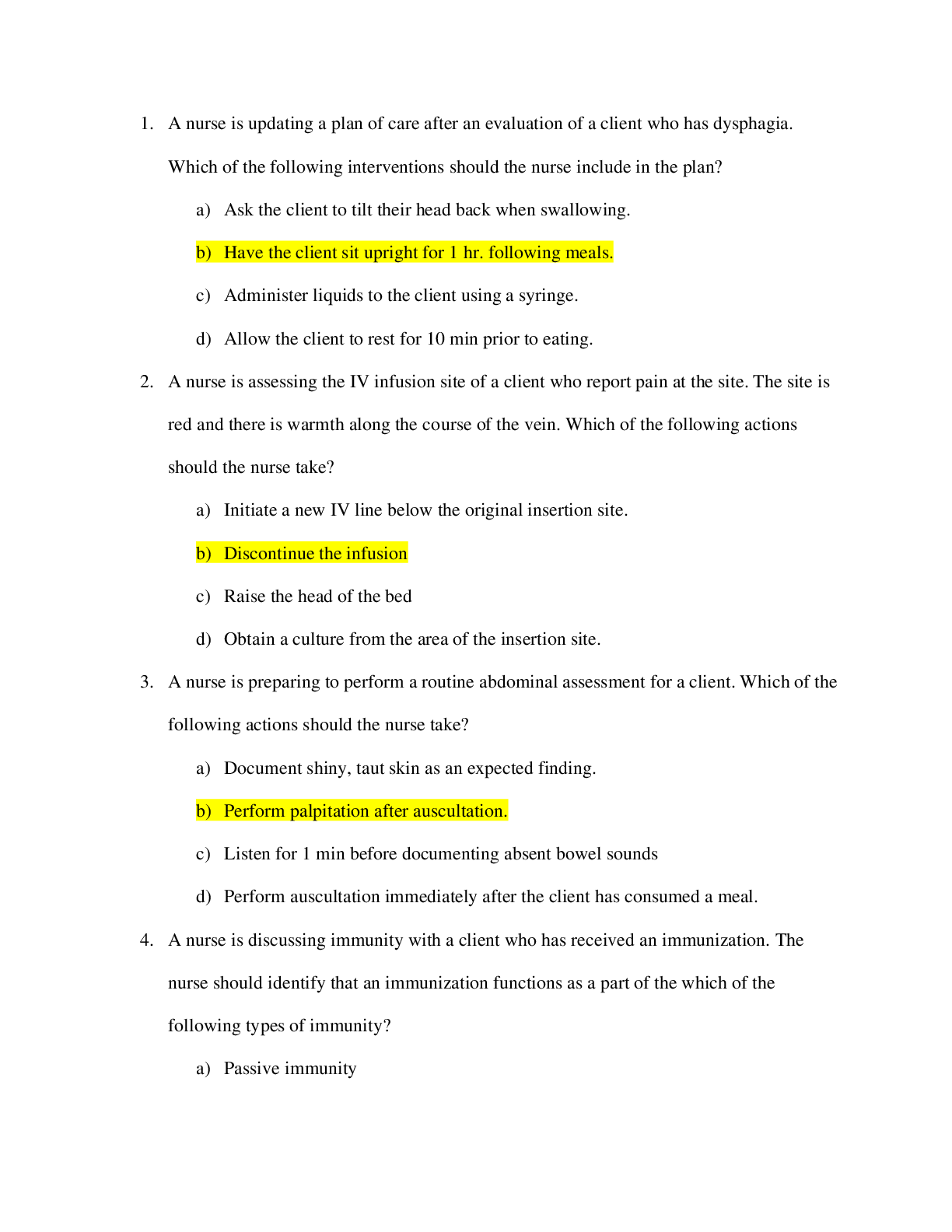
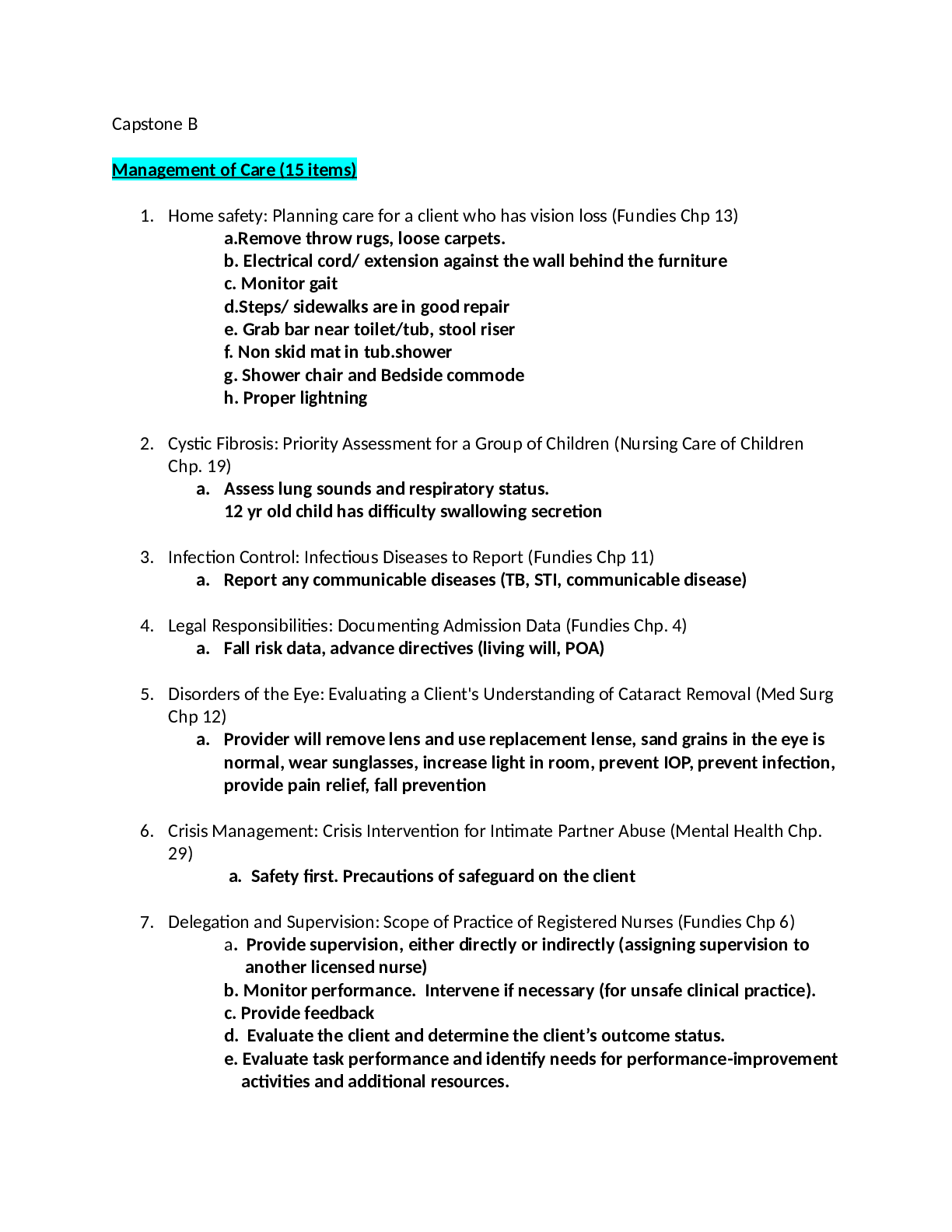
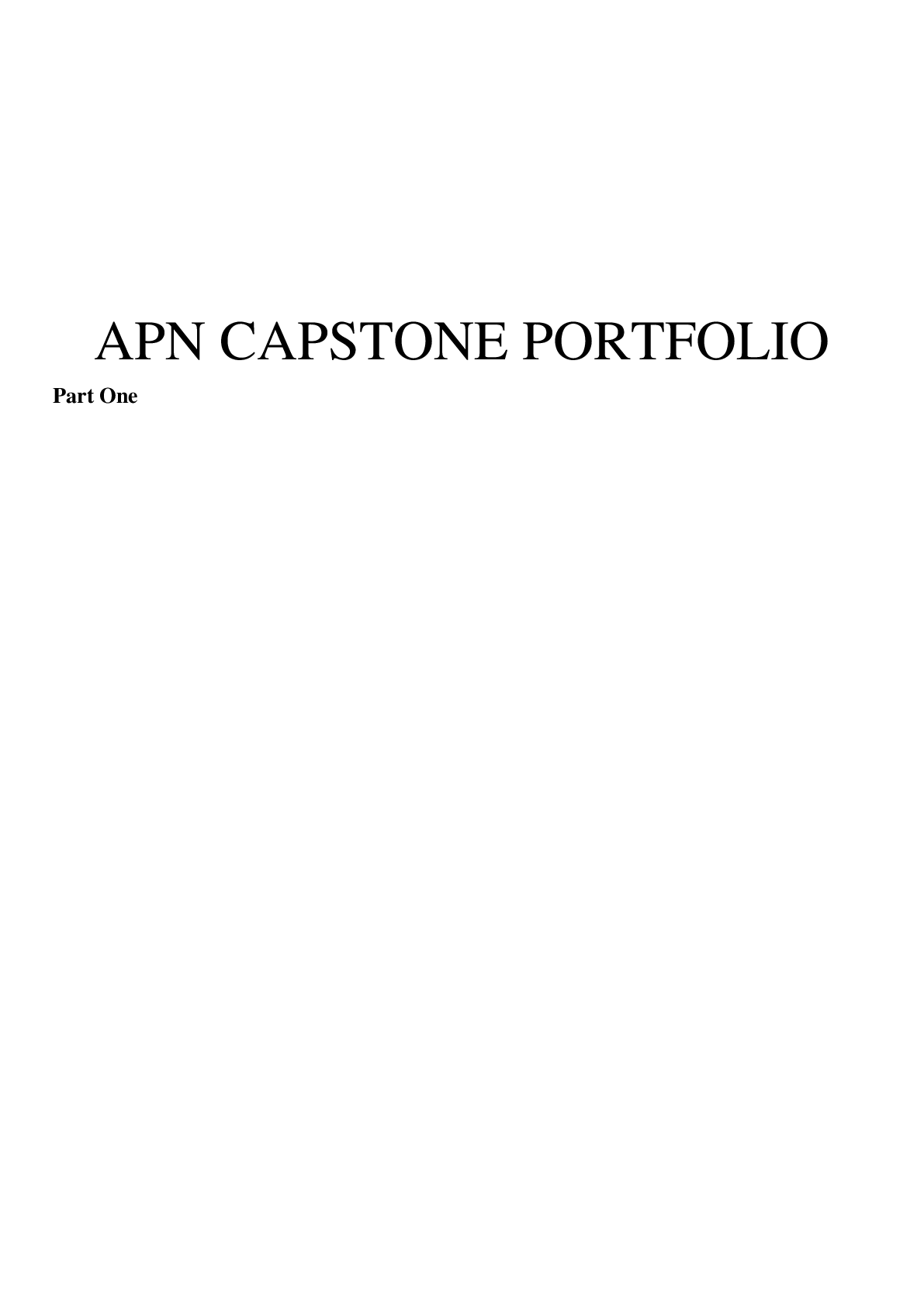

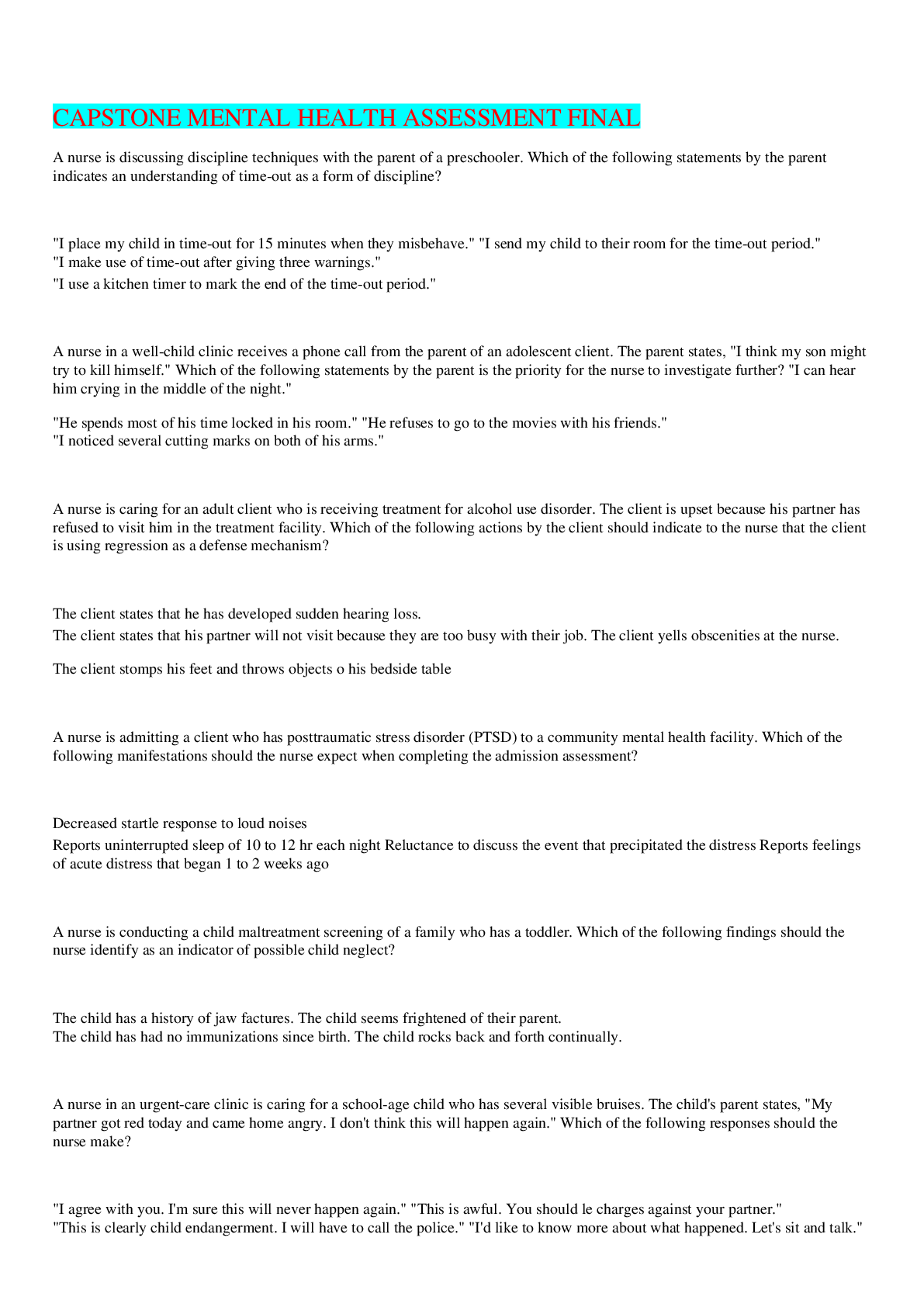
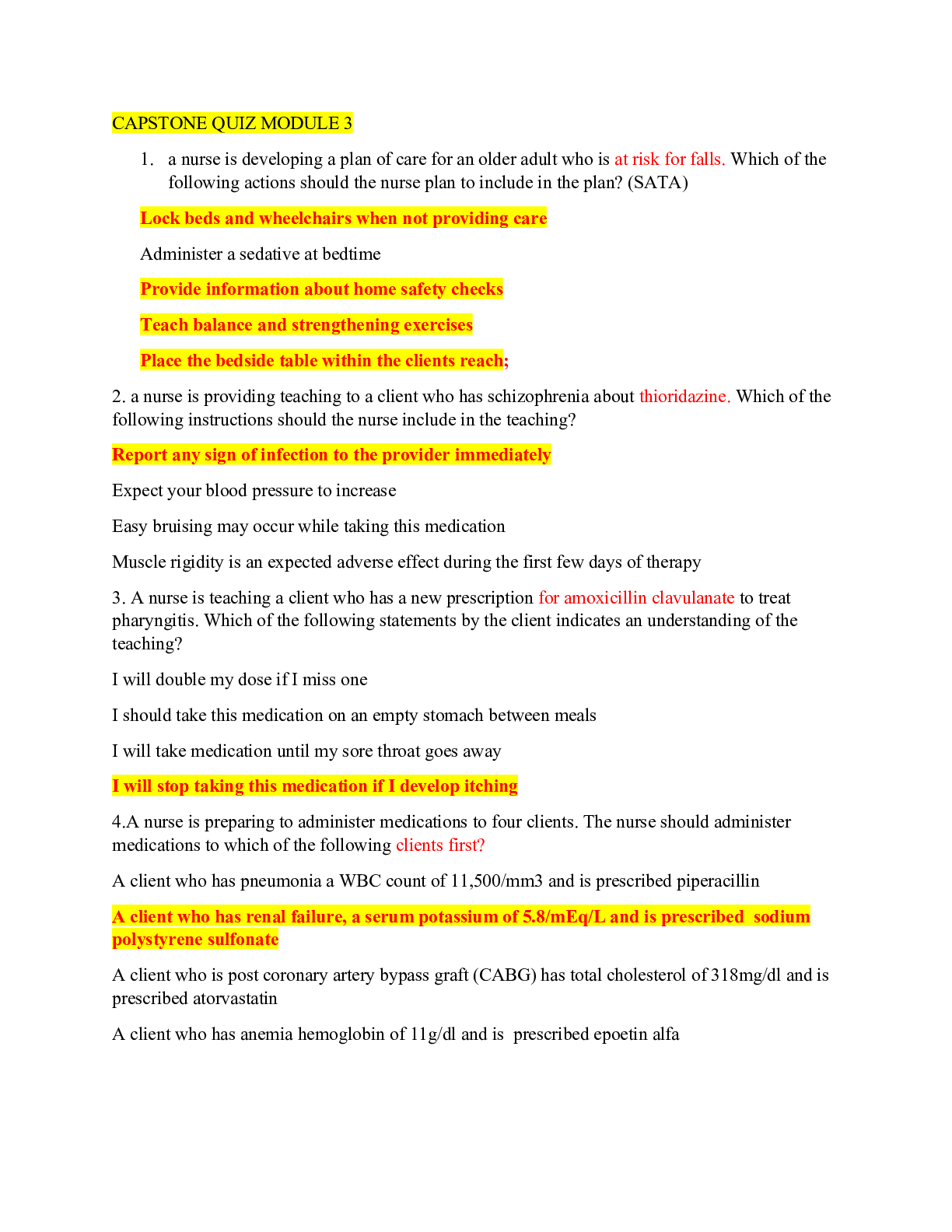
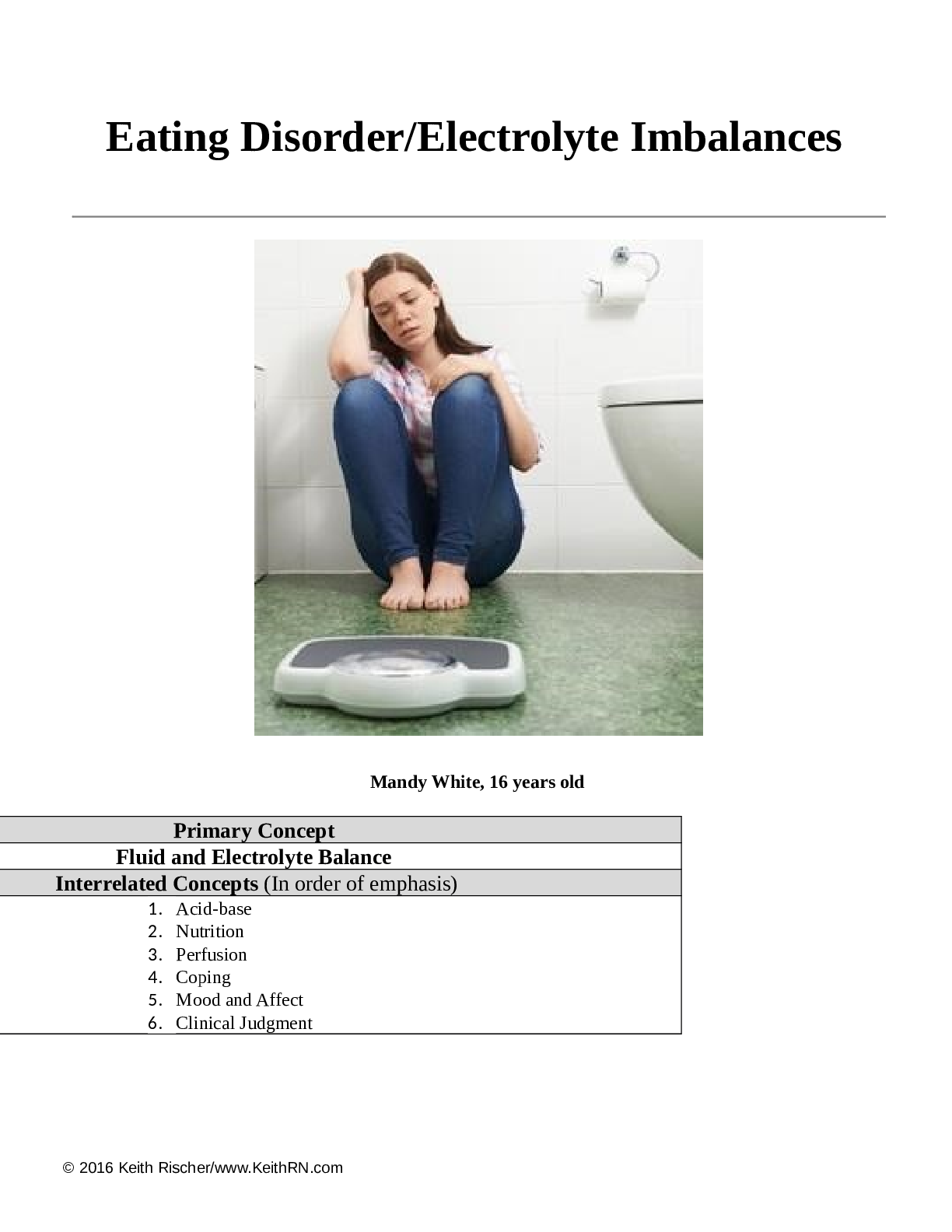
.png)
